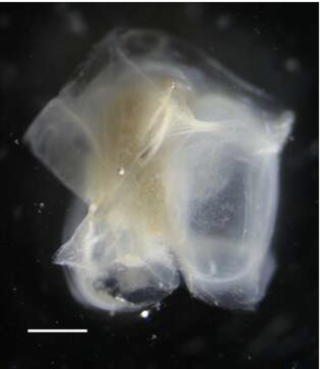
The hourglass dolphin is a small dolphin in the family Delphinidae that inhabits offshore Antarctic and sub-Antarctic waters. It is commonly seen from ships crossing the Drake Passage, but has a circumpolar distribution.

Siphonophorae is an order within Hydrozoa, which is a class of marine organisms within the phylum Cnidaria. According to the World Register of Marine Species, the order contains 175 species described thus far.

Jean René Constant Quoy was a French naval surgeon, zoologist and anatomist.

Siphonaria zelandica is a species of medium-sized air-breathing sea snail or false limpet, a marine pulmonate gastropod mollusc in the family Siphonariidae, the false limpets.

Chromodoris magnifica, also known as the magnificent sea slug is a sea slug, a species of nudibranch, a shell-less marine gastropod mollusc in the family Chromodorididae. It is the type species of the genus Chromodoris.

Laevistrombus is a genus of sea snails, marine gastropod mollusks in the family Strombidae, the true conchs.
Mexichromis lemniscata is a species of colourful sea slug or dorid nudibranch, a marine gastropod mollusk in the family Chromodorididae.

The Abylidae are a family of marine invertebrates in the order Siphonophorae. They are colonial, but the colonies can superficially resemble jellyfish; although they appear to be a single organism, each specimen is actually a colony of Siphonophora.

Siphonaria diemenensis, is a species of air-breathing sea snail or false limpet, a marine pulmonate gastropod mollusc in the family Siphonariidae, the false limpets.

Pentapodus is a genus of marine ray-finned fishes belonging to the family Nemipteridae, the threadfin breams. These fishes are found in the Indo-Pacific region.

The Diphyidae are a family of siphonophores. These are colonial siphonophores with two nectophores arranged one behind the other. The front one includes a somatocyst, while the hind one does not. The somatocyst often contains an oil droplet for buoyancy control. A nectosac in each nectophore allows the organism to swim efficiently.

Muggiaea atlantica is a species of small hydrozoan, a siphonophore in the family Diphyidae. It is a cosmopolitan species occurring in inshore waters of many of the world's oceans, and it has colonised new areas such as the North Sea and the Adriatic Sea. It is subject to large population swings, and has been held responsible for the death of farmed salmon in Norway. The species was first described by J.T. Cunningham in 1892 from a specimen obtained at Plymouth, England.
Muggiaea kochii is a species of small hydrozoan, a siphonophore in the family Diphyidae.

Physonectae is a suborder of siphonophores. In Japanese it is called 胞泳.

Calycophorae is a suborder of Siphonophores alongside two other suborders Physonectae and Cystonectae. This suborder includes the giant siphonophore, ; one of the longest lengthwise extant creatures (40–50m). While the Physonectae have a pneumatophore, nectophore, and a siphosome, Cystonectae lack a nectophore, and Calycophorae lack a pneumatophore. From the bell-shaped nectophores, Physonectae and Calycophorae are called Codonophores or Greek for bell-bearers. The distribution, morphology, and behaviors of Calycophorae species are vast and greatly depend on the species. Calycophoraes typically consist of two nectophores with a siphosome that have many tentacles that grow out of the siphosome. The Calycophoraes move by propelling water out of the nectophore much like how jellyfishes move. The tentacles act as fishing nets where the nematocysts on the tentacles paralyze their prey which are then later fed on. Calycophorae have three life stages, which are the larval development stage, the polygastric stage, and the eudoxid maturation stage. Each Calycophorae colony forms from one fertilized egg.

Abyla is a genus of colonial siphonophore in the subfamily Abylidae and the suborder Calycophorae. The genus contains three species and was established by Quoy and Gaimard in 1827.

Bassia is a monotypic siphonophore genus in the family Abylidae. The genus contains the single species Bassia bassensis.

Abylopsis tetragona is a species of siphonophore in the family Abylidae.

Abyla bicarinata is a colonial siphonophore in the family Abylidae. It was described in 1925.

Abyla haeckeli is a colonial siphonophore in the family Abylidae. It was described in 1908.

















